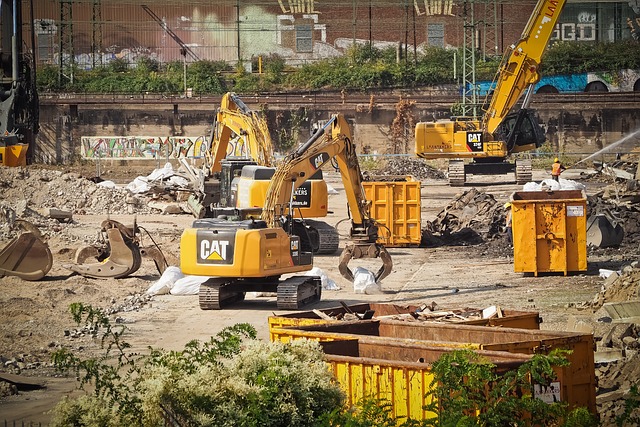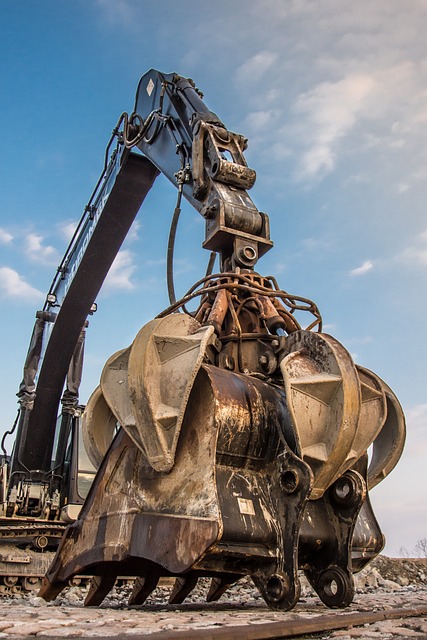Wie können wir helfen?
Construction and earthmoving machinery safety
Table of contents
Bagger
hazards
- When staying in the danger area, people can be run over and crushed.
- If excavators and load-carrying devices are not selected correctly and used as intended, employees can be injured.
- If excavators are insufficiently stable, there is a risk of overturning.
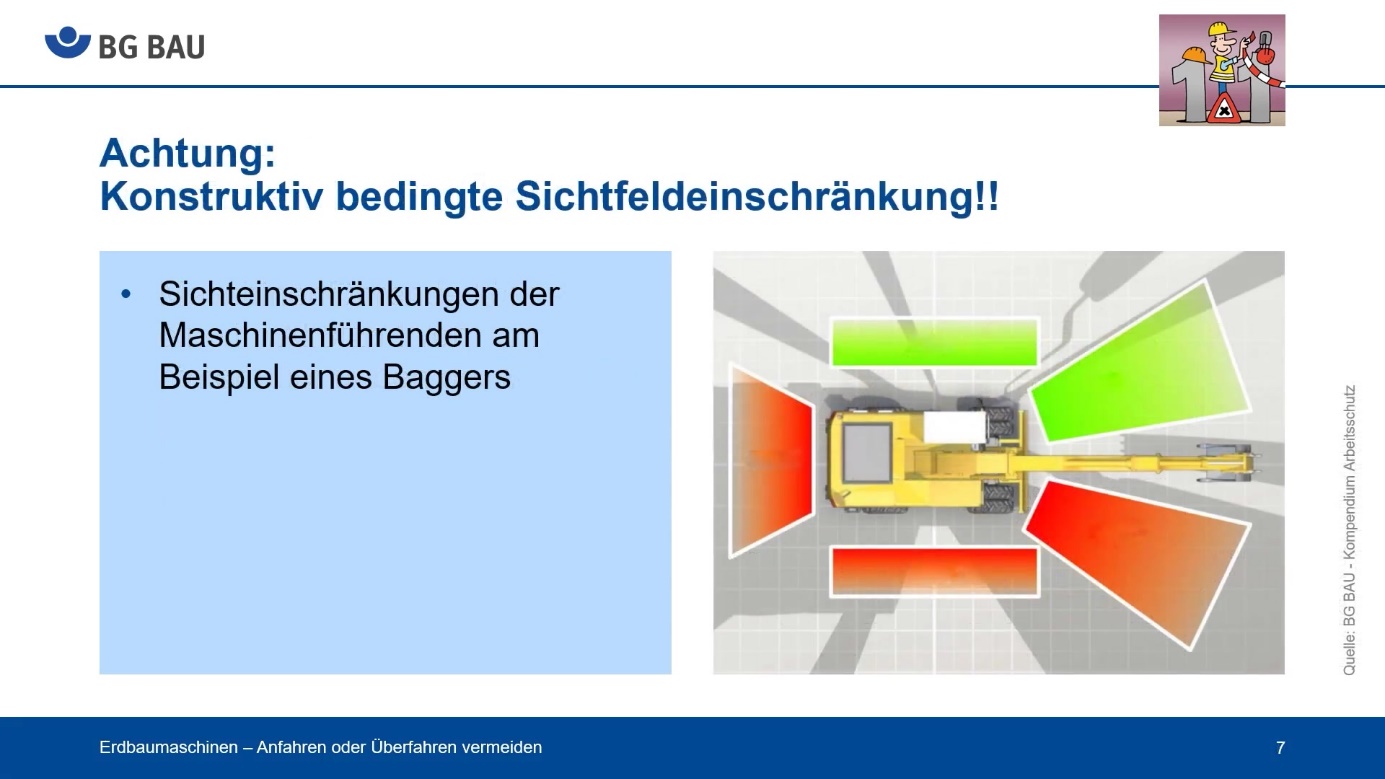
General
- Before using excavators for the first time, the entrepreneur has the machine operator:
- to commission (recommendation in writing)Download BG Bau
- to instruct him about the risks and necessary protective measures when using excavators; the instruction must be documented,
- to provide the regulations, rules and information required for the use of excavators (operating instructions, manufacturer's operating instructions) and to convey them in an understandable manner.
- The entrepreneur must have the machine operator provide proof of his or her ability to operate and maintain excavators
- Anyone who has a class C1 (formerly class 3) driving license can move machines up to 7.5 tons. In order to be able to drive self-propelled work machines weighing over 7.5 tonnes on public roads, you need a class C driving license (formerly class 2).
Obligations of the employee
-
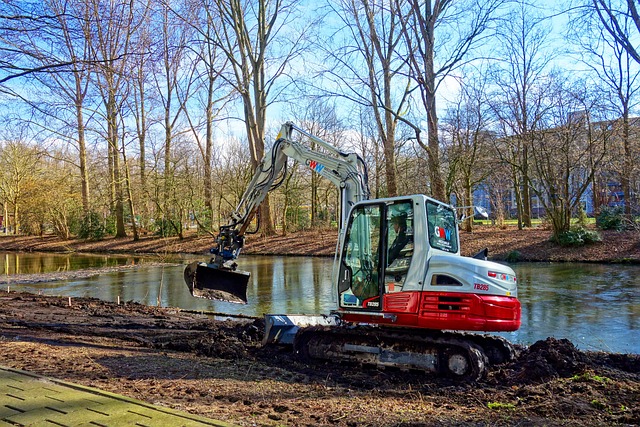
The instruction must be repeated at regular intervals.
- Wear high-visibility clothing when working near excavators.
- The machine operator must:
- be at least 18 years old,
- be reliable and suitable,
- Know the operating instructions and keep them easily accessible in the driver's seat or at the point of use,
- use the excavator as intended and
- Report any defects discovered to the supervisor.
protective measures
- At the end of operation, apply the brakes or use wheel chocks and also set down the work equipment during work breaks and before leaving.
- People are not allowed to stay in the danger area, this includes the driving or pivoting area (here brightly marked and marked with red arrows).
- A distance of 0.5m must be maintained from fixed obstacles
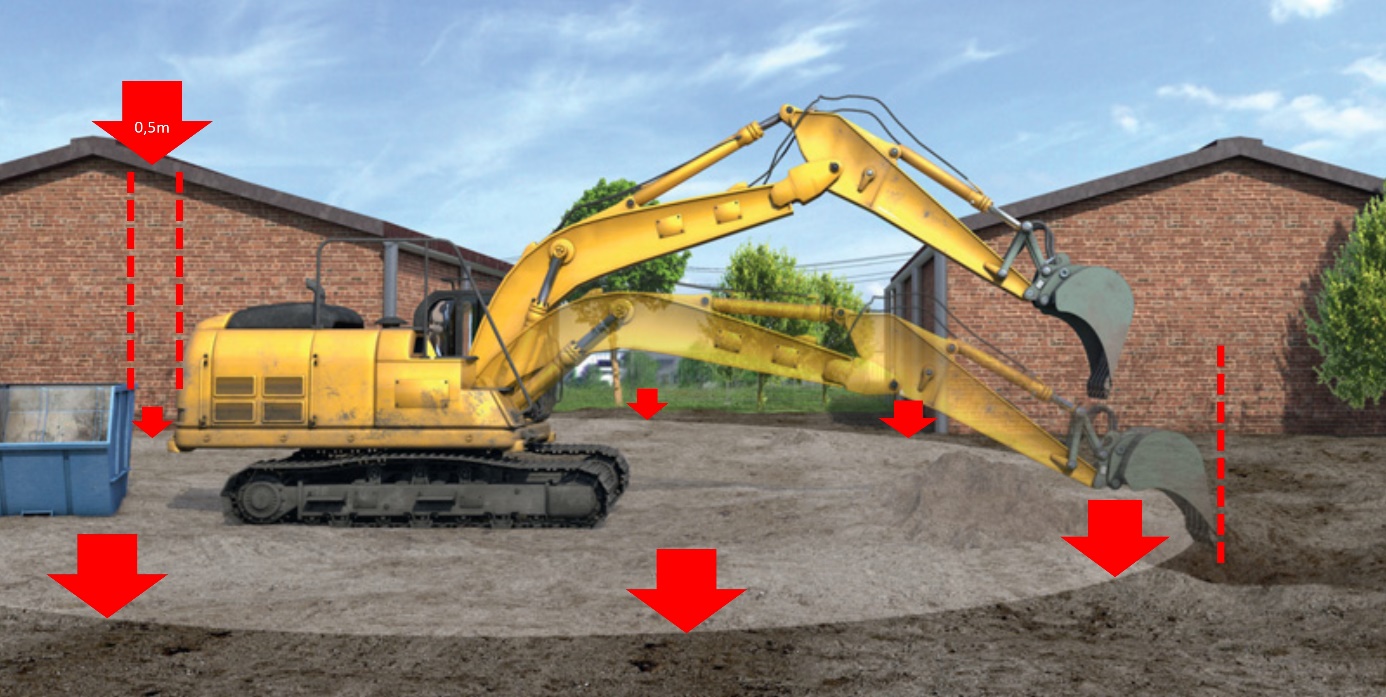
- Do not step under the raised work equipment or load.
- The machine operator is not allowed to carry out any work with the excavator if there are people in the danger area.
Exceptions possible if:
-
- unavoidable for operational reasons and
- the entrepreneur has defined measures based on a risk assessment (operating instructions). These must correspond to the state of the art.
- Check field of vision as part of the risk assessment:
- The driver must recognize employees in the respective working position (e.g. kneeling or bent over) who are working at a distance of one meter from the construction machine. If this is not the case, special protective measures must be taken for these machines.

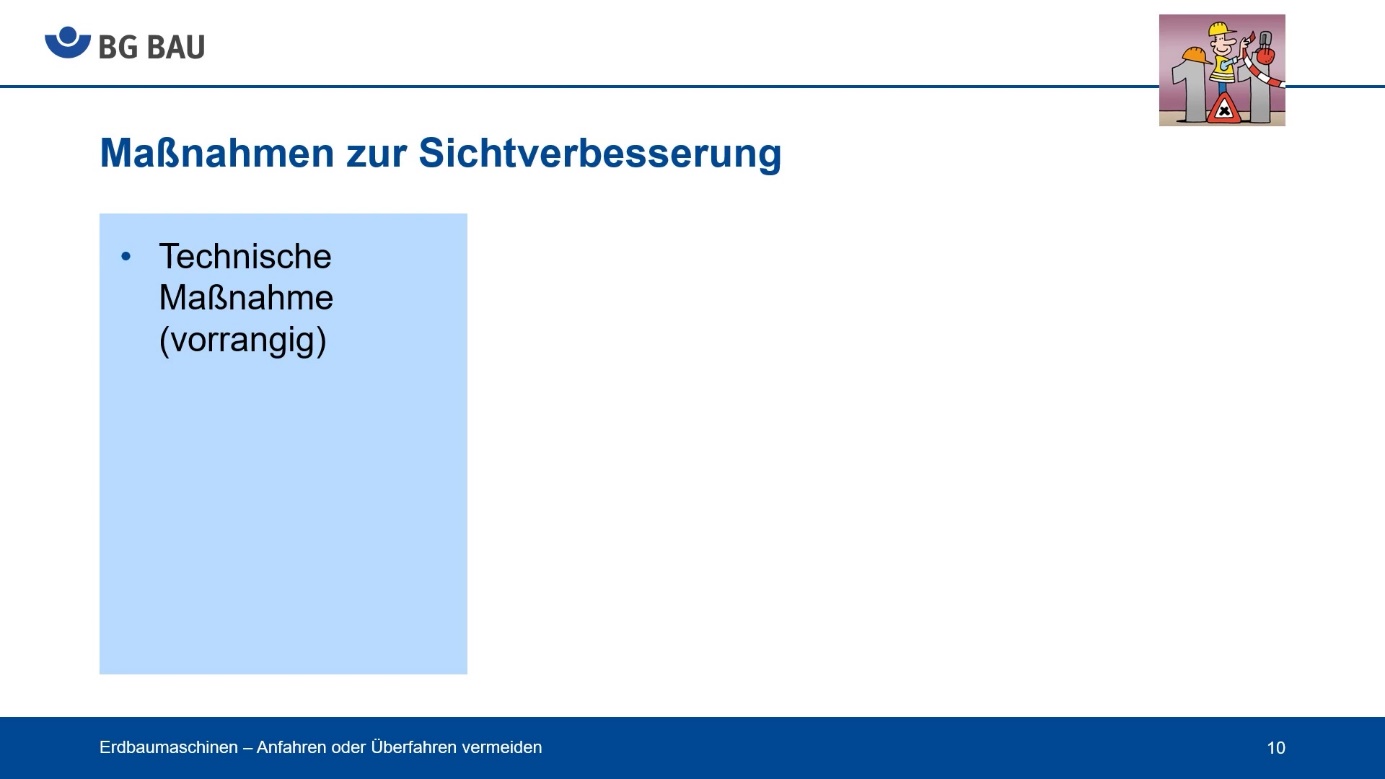
- These protective measures can be:
- Technical: additional facilities to improve visibility, e.g. B. Camera/monitor systems. Monitors or mirrors must be installed in the driver's front field of vision (max. 180° area),
- As long as technical measures cannot yet be taken, the following interim measures are suitable: use of marshals or security guards, cordoning off the danger area.

- If there is a danger to people, the machine operator must stop the dangerous movement and give warning signals.
- The following applies to people around the excavator:
- observe specified measures,
- Contact the machine operator before entering the danger area,
- Coordinate working methods with each other.
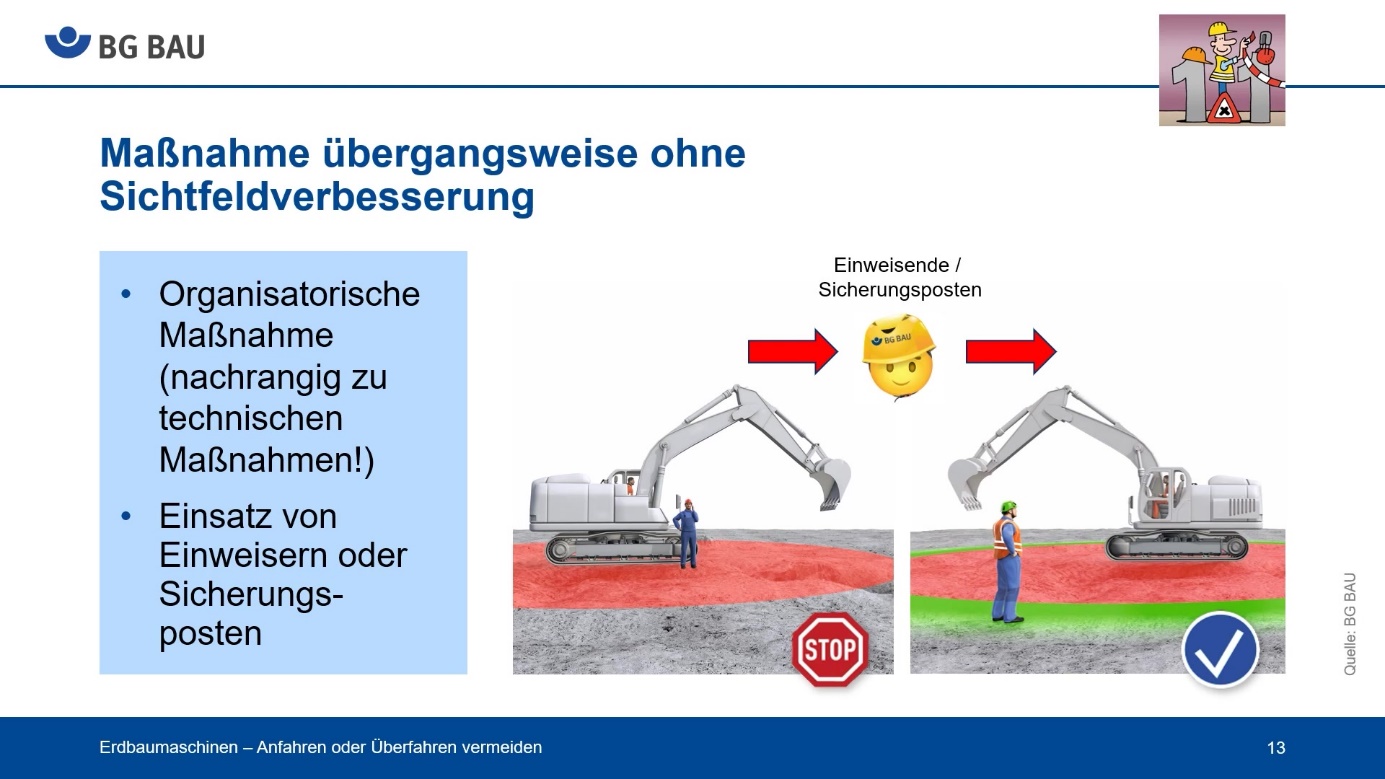
- When changing attachments with a quick-change device, the driver must check that the locking is correct.
- For excavators, standard roll-over protection and a safety belt are usually required. This belt must be worn during operation.
- To avoid the risk of crushing, maintain a safety distance of at least 0.50 m between moving parts of the excavator and fixed parts of the surrounding area.
- Before starting excavation work, determine the type and location of supply and disposal lines.
- Maintain a safe distance from ditch edges.
- Observe the following safety distances in sloped excavation pits and trenches:
- up to 12.0 t total weight ≥ 1.00 m,
- over 12.0 t to 40 t total weight ≥ 2.00 m.
- Maintain a safe distance from overhead electrical lines.
- Instruct all employees on what to do if contact with electrical lines occurs.
- During maintenance, conversion and repair work, work equipment, e.g. E.g. backhoe, secure against unintentional movement.
Additional information for excavators in hoist use
- Do not carry the load over people.
- Guide attached loads with guide ropes/guide rods.
- Persons accompanying the load and stoppers must remain within the machine operator's field of vision and outside the travel path.
- Hydraulic excavators must be equipped with an overload warning device and line break protection.
- The overload warning device must be switched on when the hoist is in operation.
- Hydraulikbaggerwith a permissible load of less than 1000 kg or a tipping moment of less than 40,000 Nm may be used in hoist operations even without overload warning devices and cable break protection devices if the manufacturer has declared this use as intended.
- draglinemust have the following safety devices:
- Safeguards against unintentional backward movement of the load,
- Emergency stop devices for the upward movement of the hoist and boom retractors,
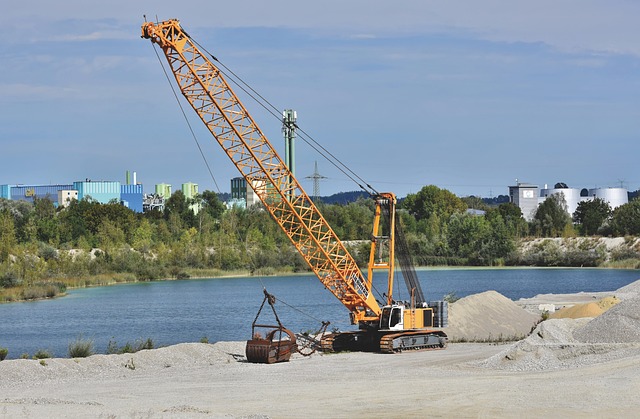 Lastmomentbegrenzer
Lastmomentbegrenzer
Additional information for excavators during demolition work
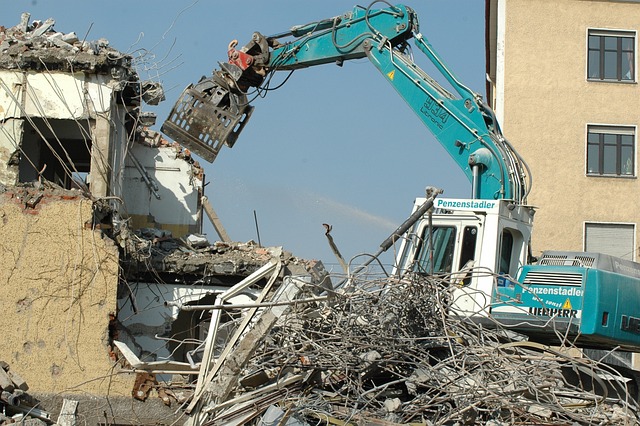
- Secure the driver's seat against falling objects, e.g. B. through standard-compliant protective structures (protective roof and front protection).
- Only use demolition equipment with sufficient reach height.
- Determine the load-bearing capacity of the subsoil, e.g. B. when working on floors.
- Maintain safety distances between devices and components to be broken off.
exams
- Determine the type, scope and deadlines of required tests (risk assessment) and comply with them, e.g. b.
- The excavator operator checks safety devices and the excavator for obvious defects before the start of each work shift, and reports any defects discovered to the supervisor,
- by a “person qualified to test” before the first commissioning and as required, but at least once a year.
- Document results.
Occupational health care
- Arrange occupational health care based on the results of the risk assessment (compulsory care) or offer it (offered care). Advice on this from the company doctor.
Additional Information:
Operational Safety Ordinance
DGUV regulation 38 construction work
DGUV Rule 100-500 Operation of work equipment
DGUV Information 201-029 “Working platforms on hydraulic excavators and loaders”
DGUV Information 203-017 Protective measures during earthworks near buried cables and pipelines
DIN 4124
DIN EN 474






